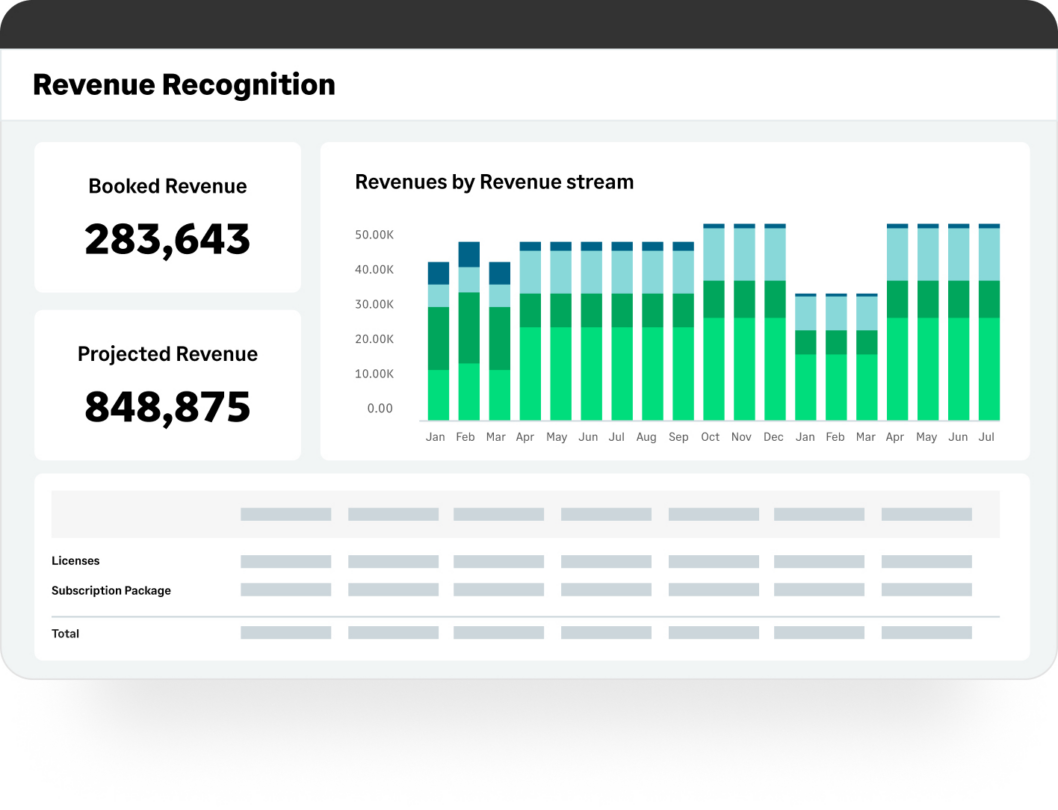Boost your revenue forecasting: tips and tricks for SaaS CFOs
Get ahead of your competition with our expert revenue forecasting tips for SaaS CFOs. Learn how to maximize your revenue with AI and ML.

Are you struggling to increase revenue for your SaaS business? Accurate forecasting is imperative for maximizing your profitability and cash flow. It helps you understand how your recurring revenue contributes to your company’s financial health and enables you to manage growth and customer retention more effectively. And that’s only the start.
In this blog, we dive into the world of SaaS revenue forecasting, leaving no stone unturned. We’ll set the stage by discussing the role of recurring revenue in your company’s ongoing success, and explore strategies to increase it.
Then we’ll highlight key metrics that you should monitor for profitable forecasting. Along the way, we’ll also explain how cloud technology optimizes SaaS forecasting for finance leaders. Let’s dig in.
Understanding the concept of SaaS revenue forecasting
Forecasting allows you to anticipate cash flow and predict revenue growth and trends. SaaS revenue forecasting relies on metrics like average revenue per user (ARPU), annual recurring revenue (ARR), and monthly recurring revenue (MRR).

Subscription SaaS businesses rely on repeated payments from users across time, as opposed to a single instance license sale. This means it’s essential to build a loyal customer base that will generate recurring revenue over long periods. More on this in a moment.
By combining cloud-based predictive analytics and historical financial data, accounting leaders can generate more accurate and robust revenue forecasts. Cloud forecasting lays the groundwork for important initiatives that help you win your market, like determining pricing strategies, evaluating economic conditions, and assessing logo churn risk.
The importance of accurate forecasting for maximizing SaaS revenue
Accurate revenue forecasting is vital for SaaS businesses to plan for future income and profit margins effectively. By accurately predicting future revenue, you can identify potential customers and target market share for future growth.
Pairing cloud forecasting with quarterly benchmarks is a fantastic way to gauge your performance against initial expectations and correct course as needed.
Many SaaS companies go through rounds of fundraising to help them reach various goals. If your company fundraises or has aspirations in that direction, you need to prioritize your forecasting. Investors certainly value historical data. But you also need to show them your company has long-term momentum and financial viability. Forecasting is your ticket there.
Role of recurring revenue in SaaS success
Recurring revenue serves as the solid foundation of the SaaS business model, offering a predictable and steady income stream on an ongoing basis. This revenue model enables businesses to shift their focus towards customer retention and upselling, paving the way to lasting profits and sustained growth.
Compared to one-time sales or one-off transactions, the recurring revenue model provides greater stability, helping SaaS companies weather challenges and fluctuations in both their target markets and the wider economy.
A few recurring revenue challenges
As we noted, recurring revenue can offer financial stability for SaaS businesses, enabling accurate revenue forecasting and somewhat more predictable financial planning.
However, you need to keep your eyes open. Challenges frequently arise in maintaining customer satisfaction, managing churn, and ensuring ongoing value delivery. None of those things just occur magically. They’re the product of careful planning and strategic effort, followed by detailed forecasting to gauge results. Then the cycle repeats, ensuring continuous improvement across time.
SaaS companies must continually provide value to justify recurring payments and require a strong customer service infrastructure with effective acquisition strategies. With much lower variance rates and robust scenario planning, cloud-based forecasting helps SaaS CFOs navigate these potential problems.
Three essential growth steps for subscription SaaS companies
Maximizing your recurring revenue has three essential growth steps connected to it. Below are some tips and strategies to maximize the success you experience at each step.
Step 1. Acquiring new customers
Developing a strategic marketing plan is crucial for reaching potential customers–sales and customer success are also essential pieces of that equation. Make sure that stakeholders across your organization have access to all the data they need to fulfill their roles effectively and easily, creating an “upward spiral” in which customer acquisition continuously becomes faster and less expensive.

Free trials or demos can entice customers to try your product and boost customer acquisition rates. Leveraging social media and online advertising can increase brand awareness, and partnering with complementary businesses expands your reach.
Revenue forecasting is a key ingredient in all three of these steps. For the first step, you’ll want to pay special attention to your customer acquisition cost (CAC). Your CAC shows you how much you spend to acquire each new user, and you want it to be as low as possible.
Step 2: Retaining your customers
Maintaining high customer satisfaction and engagement levels is crucial for retaining SaaS users–let alone convincing customers to upgrade their subscriptions. You can proactively improve your company’s retention rates by utilizing customer feedback, addressing issues promptly, and continuously improving product offerings.
Essential metrics to track and forecast for the retention phase include monthly recurring revenue (MRR) and MRR subsets like account upgrades, cross-sells, and downgrades.

Additionally, offering loyalty programs and personalized support can incentivize customers to stay for the long haul. Building strong customer relationships can lead to positive word-of-mouth referrals and revenue growth.
Step 3: Preventing churn
There are two types of customer churn. Logo churn is when a customer is dissatisfied and unsubscribes. Forecasting churn rates enables SaaS companies to identify at-risk customer segments so that customer success can conduct outreach efforts.
Involuntary churn occurs when a user’s subscription is canceled because their payment failed to process correctly. To prevent involuntary churn in your SaaS business, it’s important to implement strategies that address failed payments and credit card issues.
Automated accounting software helps finance departments significantly reduce involuntary churn. With a cloud-based solution, customers will receive automatic dunning emails if a payment fails to process. In other words, they’ll be notified of the payment failure and asked to update their info. Follow-up emails can also be sent on a customizable schedule, ensuring maximum retention.
How do you increase recurring revenue in your SaaS business?
Now that you know the three growth steps that make up SaaS recurring revenue, let’s look at two ways you can boost your recurring revenue more easily. We’ll also discuss how revenue forecasting fits into both strategies.
1. Optimizing sales funnels for increased revenue
To increase revenue, it’s crucial to optimize your sales funnel. Your funnel might perform well in the opening stages, but it might be losing prospects in the later portions that result in action being taken. Cloud-based forecasting allows you to analyze and predict customer behavior to see which contact points in your funnel are dialed in, and which ones might need help.
Automated analysis and forecasting of your sales data helps you spot bottlenecks, enabling you to optimize your funnel for stronger results.
2. Investing in forecast accuracy and robust scenario planning
Accurate financial forecasting helps SaaS companies make informed decisions and increases revenue. Cloud-based forecasting cuts variance to the bare minimum by using machine learning to assemble forecast models instead of relying on spreadsheets.

It also prepares companies for a wide range of potential financial environments and outcomes through dynamic scenario planning. Your models will shift to respond to changes in your company’s financial situation, saving time and giving you a roadmap you can rely on.
There’s an important benefit of cloud-based forecasting we still need to discuss: SaaS metrics integration.
4 key revenue metrics to monitor for profitable SaaS forecasting
One of the most useful aspects of cloud accounting is that it gives you real-time access to dozens of different SaaS metrics. In a traditional SaaS accounting department, metrics are updated in spreadsheets and kept in data silos instead of a centralized data lake.
This often results in a significant lag between when your metrics change, and the moment when you become aware of that change and can act on it. The wider that lag becomes, the more profits you’ll likely lose on missed opportunities and problems you didn’t see until it became too late. Your KPIs can even help you survive a downturn with minimal impact to your organization.
Keeping a close eye on your metrics is vital, especially your recurring revenue metrics. These KPIs show you how well you’re performing at the three steps we discussed earlier: customer acquisition, customer retention, and churn prevention.
Below are 4 of the most important recurring revenue metrics for software organizations.
1. Monthly recurring revenue (MRR)
Monthly recurring revenue (MRR) encompasses the total revenue generated from monthly subscriptions. Regularly analyzing and forecasting your company’s MRR allows you to monitor revenue growth and identify financial threats and revenue opportunities.
MRR also serves as a reliable foundation for forecasting future earnings, empowering you to make informed business decisions. By closely monitoring changes in MRR, such as customer churn levels or upgrade spikes, you can identify where you’re succeeding and what needs work.
2. Annual recurring revenue (ARR)
Annual Recurring Revenue (ARR) is a crucial metric for subscription-based companies. It represents the total revenue your company generated from annual subscriptions. ARR is calculated by multiplying your number of annual recurring customers by your average annual subscription price.
You can make informed business decisions and better forecast future revenue with accurate ARR calculations.
3. Average revenue per user (ARPU)
Average Revenue Per User (ARPU) is a metric that measures the average revenue generated by each of your customers. It can be calculated by dividing your total revenue for a given period by the number of customers you had during that timeframe. Monitoring ARPU is crucial for assessing the effectiveness of pricing strategies and upselling techniques.
ARPU provides valuable insights into the financial performance of subscription-based companies. A high ARPU indicates satisfied and loyal customers.
4. Customer lifetime value (LTV)
Customer Lifetime Value (LTV) refers to the predicted revenue a customer is expected to generate over their lifetime. It can be calculated by multiplying the average revenue per user by the average customer lifespan.
Monitoring LTV helps SaaS businesses understand the long-term value of their customer base, allowing you to prioritize high-value customers and fine-tune your customer acquisition strategies.
By increasing customer retention and maximizing revenue per customer, businesses can improve their LTV. Overall, LTV is a crucial metric for SaaS companies to gauge the profitability and sustainability of their customer relationships, and the overall state of their recurring revenue.
Look before you leap
As the CFO of a subscription SaaS company, recurring revenue is the foundation of your success. Maximizing revenue is synonymous with winning your market, but relying on outdated tech makes both of those things much more difficult for SaaS finance leaders.
The cloud offers indisputable advantages over manual forecasting, from dynamic modeling to ML-based assembly, lower variance, and more.
However, you need to be methodical about switching to automation. A successful cloud migration requires you to step back and ask five critical questions about your organization, and whether AI is right for you. Our recent ebook can help you gain clarity on your company’s unique circumstances, and assess whether you’re ready to make the leap to automated accounting. You can read it here.
5 Questions SaaS CFOs should ask before adopting AI and ML to avoid blind reliance
Learn the 5 crucial questions that will help you navigate the complex terrain of AI and ML adoption.







Ask the author a question or share your advice